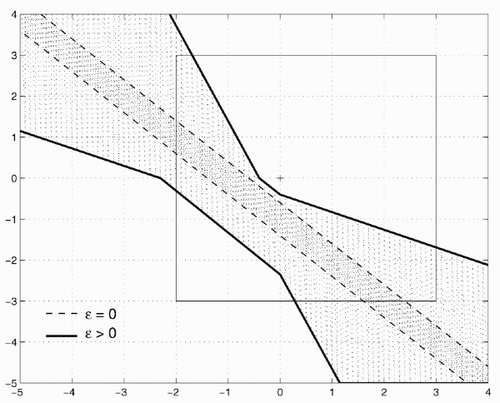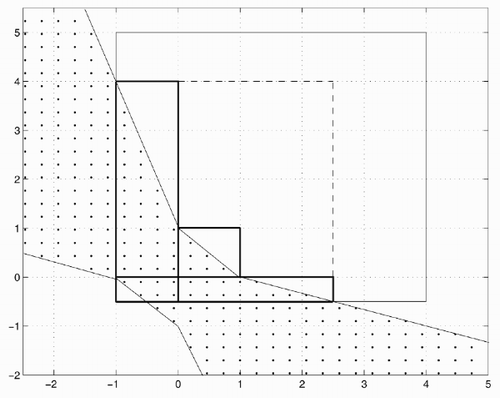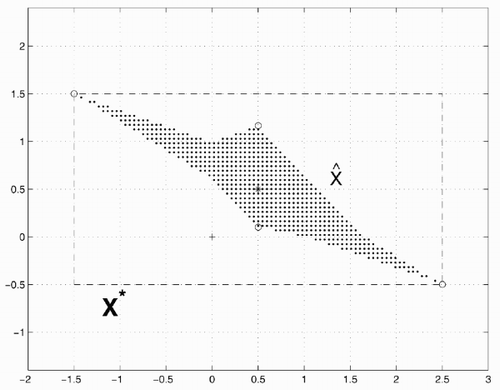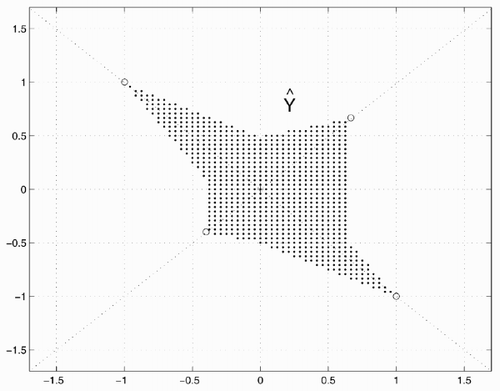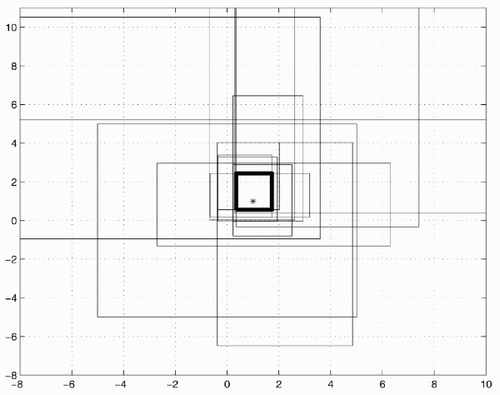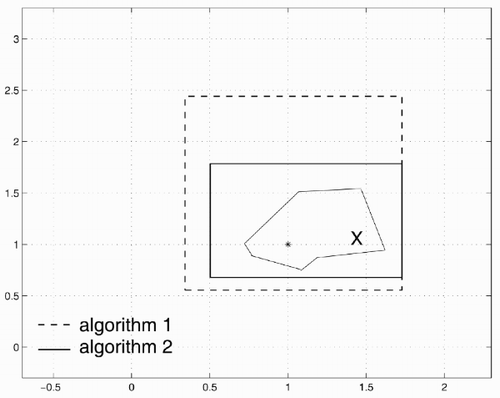Abstract
This paper is devoted to the estimation of parameters of linear multi-output models with uncertain regressors and additive noise. The uncertainty is assumed to be described by intervals. Outer-bounding interval approximations of the non-convex feasible parameter set for uncertain systems are obtained. The method is based on the calculation of the interval solution for an interval system of linear algebraic equations and provides parameter estimators for models with a large number of measurements.
1. Introduction
The set-membership estimation framework for uncertain systems has attracted much attention during the past few decades. It is an alternative to the stochastic approach where some prior information on the statistical distribution of errors is needed, because only bounds on uncertainty in system parameters and signals are required. This assumption is often much more acceptable in practice. Various types of compact sets (intervals, polytopes, ellipsoids, etc.) are usually used to characterize these bounds. They are called the membership set constraints on uncertain variables.
The parameter estimation problem for uncertain dynamic systems is one of the most natural in this context. The problem is to determine bounds or set constraints on system parameters based on output measurements, the model structure and bounds on uncertain variables. In this paper we focus on the so-called interval type of uncertainty. This means that each component of an uncertain vector or matrix is assumed to belong to a known finite interval. Although the description is natural and simple [Citation1], combinatorial difficulties may become so severe as to make estimation intractable especially in the multidimensional case. The goal of the paper is to construct an effective interval parameter estimator for an uncertain multi-output static system that can be used with large sets of data.
Consider a linear regression model under interval uncertainty
The present paper deals with the more general problem of where the matrix of regressors is also uncertain, i.e. C∈C, and C is an interval matrix (
The paper is organized as follows. Section 2 states the problem in detail. The scalar-measurement case is considered in section 3. In the multi-dimensional case the idea is to split a given linear model into a number of interval systems of linear algebraic equations. A simple method for solving these systems is proposed, which easily computes an optimal interval solution for moderate-scale problems (Section 4.2) whereas for large-scale problems effective interval over-bounding solutions are obtained (Section 4.3). The resulting method for parameter bounding is finally described in section 5.
2. Problem statement
Consider a multi-output model with measurement noise and uncertainty in the matrix of regressors
The infinity norms of matrices and vectors are equal to the maximal absolute value of their elements, i.e.
Inequality Equation(4) describes a particular case of interval uncertainty when all components of ΔC or w have the same bounds. The matrix C, vector y and scalars ϵ, δ are assumed to be known. All vectors
Assume that x∈X 0, where
3. Scalar observation
The single-measurement case (m = 1) is a good particular example of the parameter estimation. Set X for the scalar model
Assume x∈X 0. Then the smallest interval vector X containing
Notice however that the intersection of the set
Further, let
Example 1. Let X 0 = ([ − 1,4],[ − 0.5,5]) T and y = 0, c = (1,1) T , ϵ = δ = 0.5. The set
In the multi-output case, one can consider the scalar observations recursively and apply the above linear programming procedure. However this technique becomes unsuitable for models with a large number of measurements (
4. Interval system of linear algebraic equations
Let
The calculation of the interval solution for the interval system of equations Equation(12) is a challenging problem in numerical analysis and robust linear algebra. This problem was first considered in the 1960s by Oettli and Prager [Citation11]. Since then, the problem has attracted much attention and was developed in the context of the modelling of uncertain systems.
Assume that the matrix family
Our main objective is to find an interval solution of the linear interval system Equation(12), that is, to determine the smallest interval vector
In this section we briefly describe a simple approach proposed in [Citation19] for interval approximation of the solution set. Instead of employing linear programming in each orthant it is suggested to deal with a scalar equation. This method is based on Rohn's result [Citation17] and simplifies his algorithm. In order to find the optimal interval estimate
4.1. The solution set
A detailed description of the solution set for the linear interval systems was given in the pioneering work by Oettli and Prager [Citation11] for a general situation of interval uncertainty. In our case their result is reduced as follows.
Lemma 1 (Oettli & Prager [Citation11]) The set of all admissible solutions of the system Equation(12) is a non-convex polytope:
This result also follows from Equation(8). The set
Note also that the calculation of this norm is NP-hard.
While ϵ < ρ(A),
4.2. Optimal interval estimates of the solution set
The problem is to determine exact lower
Let S be the set of vertices of the unit cube
Lemma 2 (Rohn [Citation17]). For a given nominal matrix A, let the interval family
To simplify the search for vertices xs , introduce
Recall that si = ± 1; ∀i. The transformed solution set
Lemma 3 (see [Citation19]) For any regular interval family
The solution τ* of Equation(20) can be obtained using a simple iterative scheme, for example, Newton iterations
Theorem 1 The set
With these vertices we find the optimal lower and upper bounds for each component of x in the solution set
Example 2. For
4.3. Interval over-bounding technique
As already mentioned, the calculation of the optimal interval solution X* may be hard for large-dimensional problems. Hence, its simple interval over-bounding is of interest. This over-bounding is often said to be an interval solution of the interval system of equations as well. We provide below two such estimates.
According to the inequality
All vectors
Hence, the inequality Equation(24) is replaced by
Theorem 2 The interval vector
Thus the calculation of
5. Large-scale interval parameter bounding
Assume now that
In Algorithm 1, for simplicity, we assume m = Kn, where K is an integer.
Algorithm 1 Let k = 1. Assume
| 1. | Step 1: Consider the interval system of linear equations from Equation(3) that corresponds to the regressors c (kn-n + 1) , …, ckn . Compute the non-singularity radius ρ k for the nominal matrix A of this system. If ϵ < ρ k , then find its interval solution Xk, else (in particular, if A is singular) Xk is assumed to be infinitely large and go to step 3. | ||||
| 2. | Step 2: Find the smallest interval vector | ||||
| 3. | Step 3: If k = K, then terminate, else set k = k + 1 and go to step 1. | ||||
The interval solution Xk in step 1 can be calculated as described in section 2. For large-scale systems (e.g., n > 15) it can be obtained as a simple interval over-bounding, see section 3. The interval vector X computed by Algorithm 1 contains
Algorithm 2 Let k = 1. Assume X = X 0 as an initial interval approximation.
| 1. | Step 1: Consider the interval system of linear equations from Equation(3) corresponding to the regressors ck , … c k + n – 1 . Compute the non-singularity radius ρ k for the nominal matrix A of this system. If ϵ < ρ k , then find its interval solution Xk , else go to step 3. | ||||
| 2. | Step 2: Find the smallest interval vector | ||||
| 3. | Step 3: If k = m – n + 1, then terminate, else set k = k + 1 and go to step 1. | ||||
Algorithm 2 requires the solution of m – n + 1 interval systems of equations instead of m/n for Algorithm 1, but it provides a more accurate interval estimate.
Example 3 Let n = 2, m = 40 and x = (1,1) T be the parameter vector to be estimated, i.e. there are two parameters and 40 measurements in the model. The data are generated as follows. Take C be a (m × n) -matrix with rows ci , which are samples of uniformly distributed vectors on the unit sphere. Interval uncertainty is defined by ϵ = 0.2 and δ = 0.5, and then ΔC = 2ε(rand(m,n) – 0.5) and w = 2δ(rand(m,1) – 0.5). The measurement vector
6. Conclusions
In this paper we considered the parameter estimation problem for linear multi-output models under interval uncertainty. The model uncertainty involves additive measurement noise vector and a bounded uncertain regressor matrix. Outer-bounding interval approximations of the non-convex feasible parameter set for this uncertain model are obtained. The algorithms described are based on the computation of interval solutions for square interval systems of linear equations. This approach allows computational difficulties to be avoided and provides a parameter estimator for models with a large number of measurements.
Acknowledgements
This work was supported in part by grant RFBR-02-01-00127. The work of S. A. Nazin was additionally supported by grant INTAS YSF 2002-181.
References
References
- Jaulin L Kieffer M Didrit O Walter E 2001 Applied Interval Analysis London Springer
- Walter , E and Piet-Lahanier , H . 1989 . Exact recursive polyhedral description of the feasible parameter set for bounded-error models . IEEE Transactions on Automatic Control , AC-34 : 911 – 914 .
- Walter E (Ed.) 1990 Special Issue on Parameter Identification with Error Bound Mathematics and Computing in Simulation 32
- Norton JP (Ed.) 1994 Special Issue on Bounded-Error Estimation, 1 International Journal of Adaptive Control and Signal Processing 8 1
- Norton JP (Ed.) 1995 Special Issue on Bounded-Error Estimation, 2 International Journal of Adaptive Control and Signal Processing 9 2
- Milanese M Norton J Piet-Lahanier H Walter E (Eds) 1996 Bounding Approaches to System Identification New York Plenum
- Cerone , V . 1993 . Feasible parameter set for linear models with bounded errors in all variables . Automatica , 29 : 1551 – 1555 .
- Norton JP 1999 Modal robust state estimator with deterministic specification of uncertainty In: A. Garulli, A. Tesi, A. Vicino (Eds) Robustness in Identification and Control London Springer pp. 62 – 71
- Chernousko , FL and Rokityanskii , DYa. 2000 . Ellipsoidal bounds on reachable sets of dynamical systems with matrices subjected to uncertain perturbations . Journal of Optimization Theory and Applications , 104 : 1 – 19 .
- Polyak , BT , Nazin , SA , Durieu , C and Walter , E . 2004 . Ellipsoidal parameter or state estimation under model uncertainty . Automatica , 40 : 1171 – 1179 .
- Oettli , W and Prager , W . 1964 . Compatibility of approximate solution of linear equations with given error bounds for coefficients and right-hand sides . Numerical Mathematics , 6 : 405 – 409 .
- Kreinovich , V , Lakeev , AV and Noskov , SI . 1993 . Optimal solution of interval linear systems is intractable (NP-hard) . Interval Computations , 1 : 6 – 14 .
- Cope , JE and Rust , BW . 1979 . Bounds on solutions of linear systems with inaccurate data . SIAM Journal of Numerical Analysis , 16 : 950 – 963 .
- Rust BW Burrus WR 1972 Mathematical Programming and the Numerical Solution of Linear Equations New York Elsevier
- Neumaier A 1990 Interval Methods for Systems of Equations Cambridge Cambridge University Press
- Higham NJ 1996 Accuracy and Stability of Numerical Algorithms Philadelphia SIAM
- Rohn , J . 1989 . Systems of linear interval equations . Linear Algebra and Its Applications , 126 : 39 – 78 .
- Shary , SP . 1995 . On optimal solution of interval linear equations . SIAM Journal of Numerical Analysis , 32 : 610 – 630 .
- Polyak , BT and Nazin , SA . Interval solution for interval algebraic equations . Mathematics and Computing in Simulation , 66 207 – 217 .
- Polyak BT 2003 Robust linear algebra and robust aperiodicity In: A. Rantzer and C. Byrnes (Eds) Directions in Mathematical System Theory and Optimization Berlin Springer pp. 249 – 260
